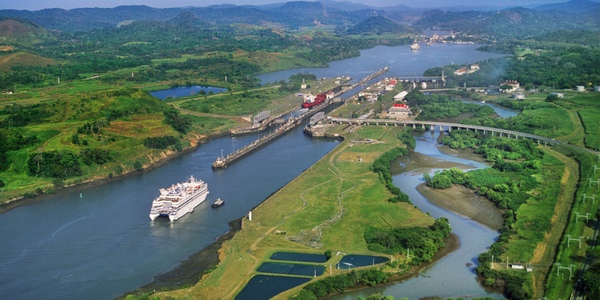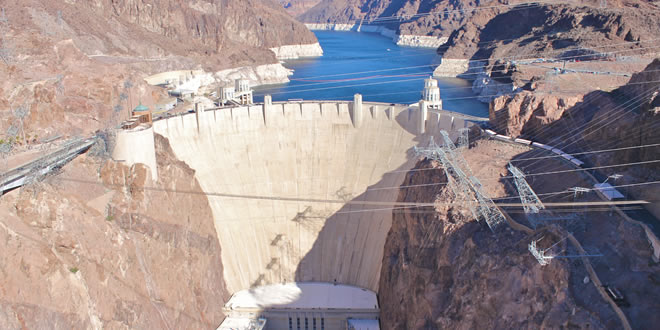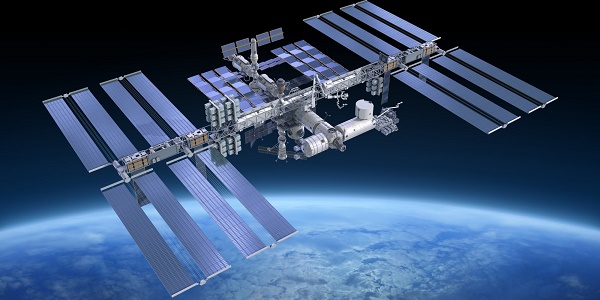10 Engineering projects which altered the course of life
There are some engineering projects that have made a strong impact on the quality of life of the people and improved economies within different regions. Others have acted as benchmarks over the years, influencing the construction and development of new projects through their innovative approach or use of new technologies. Either way, these projects have stood the test of time and remain a testament to the impact engineering has had on lives around the world.
The Panama Canal, Panama
An engineering triumph, the Panama Canal eliminated the need and risk of traveling and additional almost 13,000 kilometers around the southern end of South America to go between the Atlantic and Pacific oceans. It took centuries to actualize the dream of uniting the two oceans together and contributions of many engineers before work on this project kicked off. In 1903, Panama and the United States signed a treaty by which the United States undertook to a passageway that connects the Atlantic and Pacific Oceans across the Isthmus of Panama. The project took ten years and thousands of workers were employed to make it a success. As per the treaty signed, the United States government owned and operated the canal for 85 years, establishing it as a valuable trade route and important piece of national security for its armed forces. The agreement also gave the U.S. the right to govern the Panama Canal Zone, a 10-mile wide, 40-mile long strip of land around the canal. After some bad relations, The U.S government eventually handed back the canal back to Panama after a step-by-step transfer that ended in 1999. Today, the Panama Canal is an important source of jobs and income for the people of Panama. Additionally, many of the world’s exports and imports travel through the Canal daily. It has also inspired Nicaragua to undertake a similar project and build a canal that will rival that of Panama’s and bring economic benefits to their country as well.
The Eisenhower Interstate Highway System, USA
 Championing the formation of the Interstate System, President Dwight D. Eisenhower signed a Federal –Aid Highway Act in 1956 that saw one of the greatest public works project in the history of America get undertaken. Inspired by what he had seen in Europe as a young soldier, President Eisenhower set out to bring a similar road network to the U.S to meet the challenge of the growing number of automobiles on the nation’s highways. He also felt that the newer, multi-lane highways were essential to a strong national defense. The original nationwide design standards included a minimum of two lanes in each direction, a ten-foot right paved shoulder and design speeds of 50–70 mph. Over the years the total length of the system was expanded and today serves nearly all major U.S. cities, with many Interstates passing through downtown areas. The Interstates greatly increased the ease of travel for Americans either for work or recreation. It attracted new industries to new areas and encouraged expansion of large cities away from coastal ports. It also created a mass amount of needed workers, to build and maintain the highways as well as increased the purchase and use of the automobile.
Championing the formation of the Interstate System, President Dwight D. Eisenhower signed a Federal –Aid Highway Act in 1956 that saw one of the greatest public works project in the history of America get undertaken. Inspired by what he had seen in Europe as a young soldier, President Eisenhower set out to bring a similar road network to the U.S to meet the challenge of the growing number of automobiles on the nation’s highways. He also felt that the newer, multi-lane highways were essential to a strong national defense. The original nationwide design standards included a minimum of two lanes in each direction, a ten-foot right paved shoulder and design speeds of 50–70 mph. Over the years the total length of the system was expanded and today serves nearly all major U.S. cities, with many Interstates passing through downtown areas. The Interstates greatly increased the ease of travel for Americans either for work or recreation. It attracted new industries to new areas and encouraged expansion of large cities away from coastal ports. It also created a mass amount of needed workers, to build and maintain the highways as well as increased the purchase and use of the automobile.
The Great Man-Made River, Libya
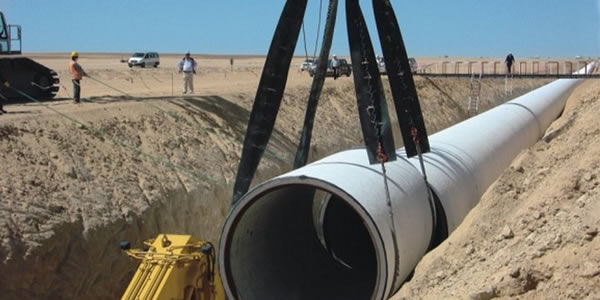 Sparked by controversy, the Great Man-Made River is cited as the largest irrigation project in the world. Much of Libya’s water supply used to come from expensive desalination plants on the coast, which left little water to irrigate land in the desert country. During exploration drilling for oil in the 1950s, water was first discovered in the Al-Kufrah area in Libya’s southeastern desert. In 1983, a massive engineering project was instigated to supply water from desert aquifers to the coastal region for the majority of the Libya’s people and to expand agriculture through irrigation. The project took on a network of underground pipelines to bring high-quality fresh water from ancient underground aquifers deep in the Sahara to the coast of Libya for domestic use, agriculture, and industry. The fresh clean water provided to the Libyans by the Great Man-Made River is essential to all life forms in that region. Unfortunately, due to political battles in the country this valuable project has been undermined and is used as a tool of power by warring factions.
Sparked by controversy, the Great Man-Made River is cited as the largest irrigation project in the world. Much of Libya’s water supply used to come from expensive desalination plants on the coast, which left little water to irrigate land in the desert country. During exploration drilling for oil in the 1950s, water was first discovered in the Al-Kufrah area in Libya’s southeastern desert. In 1983, a massive engineering project was instigated to supply water from desert aquifers to the coastal region for the majority of the Libya’s people and to expand agriculture through irrigation. The project took on a network of underground pipelines to bring high-quality fresh water from ancient underground aquifers deep in the Sahara to the coast of Libya for domestic use, agriculture, and industry. The fresh clean water provided to the Libyans by the Great Man-Made River is essential to all life forms in that region. Unfortunately, due to political battles in the country this valuable project has been undermined and is used as a tool of power by warring factions.
The Hoover Dam, USA
At the time of the construction of the Hoover Dam, there was a global economic crisis that left millions jobless. Rising 726 feet high, the Hoover Dam was constructed to control floods and silt, irrigation and generate electricity. The Hoover Dam also created the largest manmade reservoir in the United States, Lake Mead which provides a large site for outdoor recreation. An icon for modernism, the Hoover Dam provided work for unemployed men and women in the country. It embraced a forward-looking design that required new materials and new techniques to successfully complete the project. The Hoover Dam became a metaphor for the positive power of a government and a nation’s ability to tackle a seemingly impossible project.
The Large Hadron Collider, Switzerland
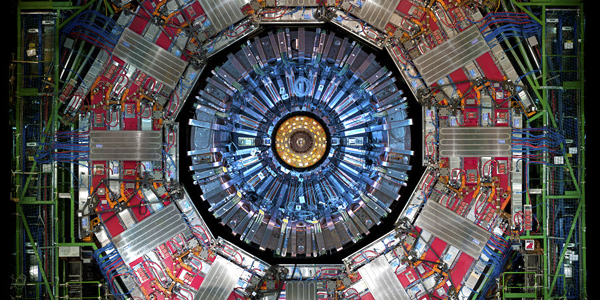 The large Hadron Collider is located at the European Organization for Nuclear Research (known as CERN) which is the world’s largest particle physics laboratory and holds some of the world’s best physicists and engineers. Advanced particle accelerators are used to help solve age old questions about the universe like what it’s made of and how it started. The work of ten thousand men and women from across the globe, the Large Hadron Collider is the world’s largest and most powerful particle accelerator and could provide important new clues about conditions in the very early universe such as when the four forces of nature were rolled into one giant superforce.
The large Hadron Collider is located at the European Organization for Nuclear Research (known as CERN) which is the world’s largest particle physics laboratory and holds some of the world’s best physicists and engineers. Advanced particle accelerators are used to help solve age old questions about the universe like what it’s made of and how it started. The work of ten thousand men and women from across the globe, the Large Hadron Collider is the world’s largest and most powerful particle accelerator and could provide important new clues about conditions in the very early universe such as when the four forces of nature were rolled into one giant superforce.
The Sydney Opera House, Australia
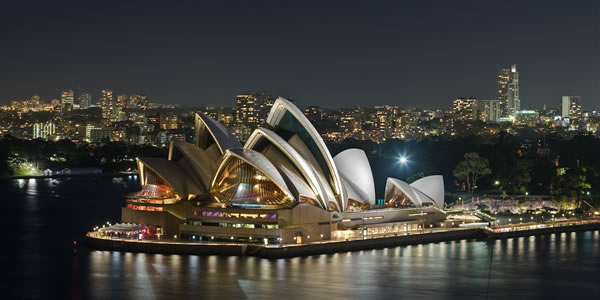 One of Australia’s most famous landmarks and a hub for the city’s cultural scene, the Sydney Opera House was one of the most daring and difficult engineering feats ever attempted at the time. It continues to be heralded as a great architectural work of the 20th century and was inscribed in the World Heritage List in June 2007. It took 14 years to complete and cost about $99 million. The building is designed as a soaring white roof shell shaped sails atop a massive red granite platform and can be seen and experienced from all sides. With an enduring influence on architecture, the building fuses creativity and innovation both architectural form and structural design. Danish architect Jørn Utzon was widely recognized and applauded for his radical new approach to design and construction. The design solution and construction of the shell structure took eight years to complete and the development of the special ceramic tiles for the shells took over three years. While complex engineering problems and escalating costs made it a source of great public debate, all this subsided when the beauty and achievement of the completed building placed it on the world stage. The Sydney Opera House remains a challenging, graceful piece of urban sculpture in modern time.
One of Australia’s most famous landmarks and a hub for the city’s cultural scene, the Sydney Opera House was one of the most daring and difficult engineering feats ever attempted at the time. It continues to be heralded as a great architectural work of the 20th century and was inscribed in the World Heritage List in June 2007. It took 14 years to complete and cost about $99 million. The building is designed as a soaring white roof shell shaped sails atop a massive red granite platform and can be seen and experienced from all sides. With an enduring influence on architecture, the building fuses creativity and innovation both architectural form and structural design. Danish architect Jørn Utzon was widely recognized and applauded for his radical new approach to design and construction. The design solution and construction of the shell structure took eight years to complete and the development of the special ceramic tiles for the shells took over three years. While complex engineering problems and escalating costs made it a source of great public debate, all this subsided when the beauty and achievement of the completed building placed it on the world stage. The Sydney Opera House remains a challenging, graceful piece of urban sculpture in modern time.
The Polar Umbrella, The Arctic
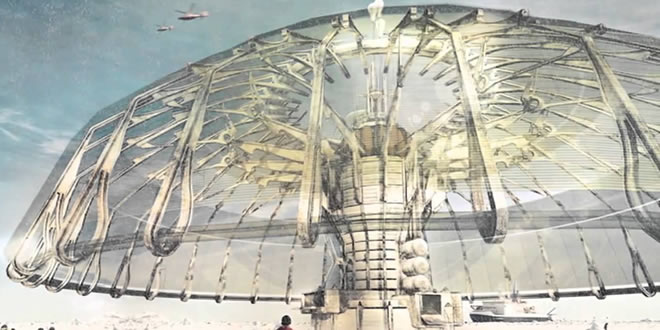 Designed to rebuild the shrinking polar ice sheets affected by global warming, the Polar Umbrella is a buoyant skyscraper designed by Derek Pirozzi. Through its desalinization and power facilities, the Polar Umbrella resembles a floating metropolis equipped with NOAA (National Oceanic and Atmospheric Administration) research laboratories, renewable power stations, dormitory-style housing units, eco-tourist attractions, and ecological habitats for wildlife. The structure will travel to the most affected areas where global warming has caused the most damage to the Earth’s protective ice cover and reconstitute layers of ice before moving on to other locations.
Designed to rebuild the shrinking polar ice sheets affected by global warming, the Polar Umbrella is a buoyant skyscraper designed by Derek Pirozzi. Through its desalinization and power facilities, the Polar Umbrella resembles a floating metropolis equipped with NOAA (National Oceanic and Atmospheric Administration) research laboratories, renewable power stations, dormitory-style housing units, eco-tourist attractions, and ecological habitats for wildlife. The structure will travel to the most affected areas where global warming has caused the most damage to the Earth’s protective ice cover and reconstitute layers of ice before moving on to other locations.
Pan STARRS-1, Hawaii
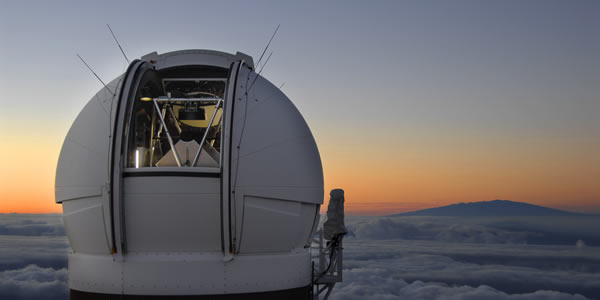 Installed on the Pan STARRS-1 telescope is the world’s largest digital camera. A collaboration between ten research organizations in four countries, Pan STARRS-1 forms one of the most powerful observatories on the planet and will monitor the cosmos constantly. It was built purposefully to discover and characterize Earth-approaching objects, both asteroids & comets that might pose a danger to our planet. Already, scientists have used the telescope to discover new planets.
Installed on the Pan STARRS-1 telescope is the world’s largest digital camera. A collaboration between ten research organizations in four countries, Pan STARRS-1 forms one of the most powerful observatories on the planet and will monitor the cosmos constantly. It was built purposefully to discover and characterize Earth-approaching objects, both asteroids & comets that might pose a danger to our planet. Already, scientists have used the telescope to discover new planets.
The Aswan High Dam, Egypt
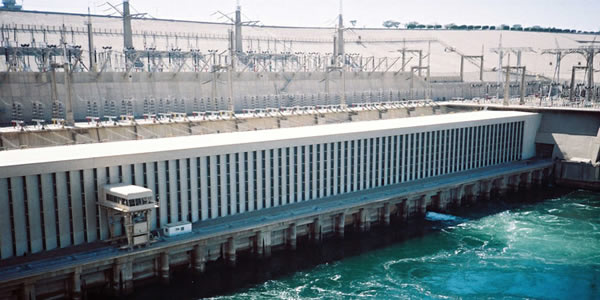 Egypt was once plagued by the annual floods of the Nile River that would deposit rich, arable soil along the banks after the floodwaters receded. In some years there would be no water at all, leading to drought within the region. In the years there was water, it would be too much and wash away the fertile land and destroy crops. In 1899, construction on the first Aswan dam began. While it provided valuable irrigation during droughts it could not hold back the annual flood of the mighty Nile River. The Egyptian President at the time, Gamel Abdel Nasser, set out to build a bigger dam in 1959. With help from the Soviets, the Aswan High Dams was constructed, a rock fill dam with grout curtain and clay core. More than 12, 000 feet long and 3,200 feet wide at the base, the dam was finished in 1970. It helps to control the annual flooding of the Nile River and, as a result of the irrigation capacity of the reservoir, has led to a 200-percent increase in the country’s agricultural income. When it first reached its peak output it produced around half of Egypt’s entire electricity production and allowed most Egyptian villages to use electricity for the first time. Additionally, the dam also created Lake Nasser, one of the world’s largest artificially-made freshwater lakes which provides for recreation and a greater fishing industry in the inland regions.
Egypt was once plagued by the annual floods of the Nile River that would deposit rich, arable soil along the banks after the floodwaters receded. In some years there would be no water at all, leading to drought within the region. In the years there was water, it would be too much and wash away the fertile land and destroy crops. In 1899, construction on the first Aswan dam began. While it provided valuable irrigation during droughts it could not hold back the annual flood of the mighty Nile River. The Egyptian President at the time, Gamel Abdel Nasser, set out to build a bigger dam in 1959. With help from the Soviets, the Aswan High Dams was constructed, a rock fill dam with grout curtain and clay core. More than 12, 000 feet long and 3,200 feet wide at the base, the dam was finished in 1970. It helps to control the annual flooding of the Nile River and, as a result of the irrigation capacity of the reservoir, has led to a 200-percent increase in the country’s agricultural income. When it first reached its peak output it produced around half of Egypt’s entire electricity production and allowed most Egyptian villages to use electricity for the first time. Additionally, the dam also created Lake Nasser, one of the world’s largest artificially-made freshwater lakes which provides for recreation and a greater fishing industry in the inland regions.
The International Space Station
The International Space Station (ISS) is a research facility that is a joint project among the space agencies of the several countries.A glowing tribute to human will and skill, construction of the massive structure started in 1998 and ran up until 2011 even though continuous improvements are still on-going. A microgravity and space environment research vessel, researchers can conduct experiments in biology, physics, astronomy, meteorology and other fields. It has been continuously occupied for over 12 years. It remains a significant aerospace engineering accomplishment that has resulted in significant science and technology advancements.
